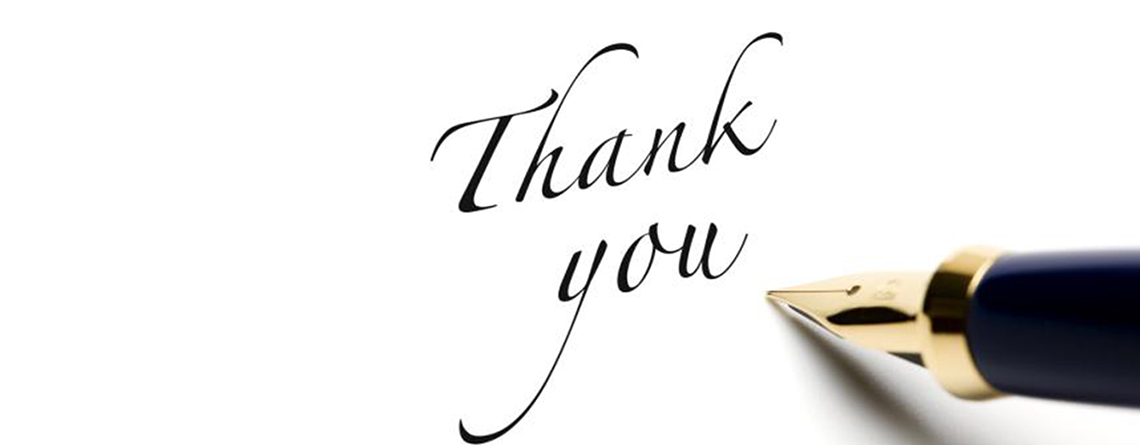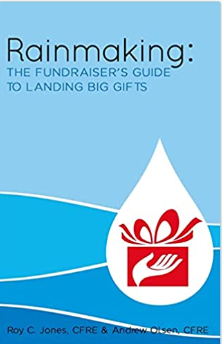The amount and timing of your next gift is directly connected to the way you say “Thank You.”
Rule #1: Thank Donors Faster. You can never thank a donor too much or too fast! I’ve encouraged charities to stop batching thank you receipts for the postal discount. They are always shocked when I tell them to spend more money to get their thank you’s out immediately. Last year I visited 73 different charities, as a matter of factm over the last three years I’ve visited more than 300 non-profits and more than half were doing it wrong.
Use a first class stamp and a lasered letter to get the initial receipt in the mail faster. Always, always, always enclose a reply envelope. Do not use a reply for gifts over $1000. Do not make an additional ask in the thank you. Just add an extra envelope that is coded so your staff will know it is a “thank you receipt donation.” Some charities will just have a letter code, small dot, or a small sticker on the flap side so you’ll know the envelope is from a thank you receipt. Thank you receipt income is often an additional revenue stream for a charity, boosting overall income by 10 to 20 percent.
Don’t batch your initial receipt for the President to hand sign. (The president can do an additional thank you note or letter.) Getting receipts out FAST is more important than getting receipts perfect. The faster the turnaround of your thank you and acknowledgement letter, the more likely it is that a donor will send a second gift. Yes, a donation from the thank you letter. I’ve personally tracked it and have had dozens of clients measure the impact of “speed to receipt” over the years.
Charity leaders are often shocked that as many as 20% (yes, 1 out of 5) of all donors will send a second gift if thanked within 24 hours. The second check is usually smaller than the initial donation, but it adds up fast. However, if you wait 72 hours the response rate drops to 10%… wait a week and it drops to 5%… wait two weeks and there is no measurable lift in giving at all.
Rule #2: You Cannot Thank A Donor Too Much! Additional thank you notes for a single gift are critical to building friendship and trust with your financial partners. Set up parameters based upon gift amounts and assign specific people in your organization to call, email and send hand written notes. I have seen great charities thank donors 5, 6 or 7 times for a single key gift. Here are six examples of how to thank a donor for the same gift:
- Official thank you receipt within 24 hours
- Handwritten note by the president
- A phone call from the VP of Development
- Handwritten note from a board member
- An emailed Impact report of the gift from a program director with a testimony
- A hand made card or coloring page from a child helped by the program
Remember, donors and especially major gift partners are looking for you to demonstrate return on investment or impact. Big givers do not make donations, they make investments. They want to see return on investment or impact from their giving.
Rule #3: Use Social Media and Your Website. Pick a “friend of the day” and recognize them on Facebook, Instagram, Twitter and on your website. Develop a stewardship section on your website which can appeal to both one-time donors and recurring donors. Posting a message on your website that promotes thankfulness creates a culture of giving and stewardship for your staff, volunteers and donors.
Rule #4: Celebrate Every NEW Donor. Don’t be afraid to go over the top with your new donors. A welcome package should both educate and celebrate your new donors decision to partner with your organization. A welcome package should be more than a letter. I like welcome kits that involve the donor with surveys or “bounce back” (cards and notes which can be used by your charity and those that you care for). Connecting your new donor to the mission of your group is critical. Put a new donor to work by giving them cards to sign and send back or prayer & care cards to return.
These kinds of items connect your donor to the mission of your organization. Of course, there is nothing wrong with a small gift or something special for the donor to keep. Be careful that your welcome package is not just chocked full of facts and figures… and always enclose a reply envelope without an “ask” for a gift.
Here Are My “Quick Six” Thank You Ideas:
#5: Stand Up Videos From the Field. Every day (or at least once a week) pick 10 donors from the day before and use your iPhone to record a video thanking the donor by name with you standing in the middle of some of the great work you do. 15 to 30 second “stand ups” of you thanking the donor by name, surrounded by the people you serve, will mean so much to the donor. IT DOES NOT NEED TO BE EDITED… no background music, no banner copy, no toll free numbers. The grittier the video is the better. You will be amazed at the impact this has on the donor and as importantly, you will be blown away by the impact it will have on your organization. Everyone will want to get in on the video to thank the donor. It creates a real “culture of philanthropy” for your co-workers and the people you serve when they see you taking the time everyday to thank 5 or 10 donors.
#6: Create a Stewardship Treatment. Everyone on your staff should know how we are going to thank donors based upon giving level. It is critical to creating a culture of philanthropy for your charity. Spell out clearly what you’ll do for donors who give at various levels, for instance, $1 to $99, $100 to $499, $500 to $999, $1,000 to $4,999, $5,000 to $9,999, $10,000+.
#7: Birthdays and Anniversaries. Send personalized, hand signed, birthday cards and wedding anniversary cards to your middle and major donors. Any donor giving you $1,000 or more a year should get this kind of attention. Do not print them on fancy, formal logo stock. Donors will think it is just a mass mailing program if it looks too slick. Instead, use a Hallmark or store bought card. You can drop in your business card. Always hand sign each card with a unique message from one year to the next.
#8. Start A Donor Thank You Day. Pick a day and dedicate it to thanking donors. It could be once a year. It could be once a month. It could be once a week. Encourage everyone in your ministry or nonprofit to identify donors who do something special and thank them. Most importantly, create a process for your staff and volunteers to push donor testimonials up the management ladder so that you and other leaders in the organization can thank them too. A donor appreciation day helps build a culture of philanthropy in your organization.
#9: Anniversary Card for Joining the Charity. Recognize donor loyalty on the date that they made their initial gift, especially those that currently give more than $1,000 a year to your charity. Make this card as special as you can. In addition, send them a certificate or a gift for special benchmarks at 5 years, 10 years,15 years, and 20 years of giving.
#10: Use Photo Books and Personalized Giving Pages. Your biggest donors should be reminded of the impact they are having on your organization. Creating a photo book or personalized web page for major donors that are customized with photos of the donor and the project they support financially. As importantly, stage photos with those that were helped holding thank you cards or signs naming the donor by name. ShutterFly, SnapFish and Mixbook are great online resources, but a lot of companies have moved into the personalized book space. Walmart, Walgreens and even CVS can publish photo books for you. Remember, the older your donor is the more likely it is they will appreciate the paper version over a digital one. But trust me, even young people and young families enjoy the paper version.
Conclusion
Building a culture of philanthropy begins by saying thank you. Remember that saying thank you, if done the right way, can impact your organization as much as it does the donor. And don’t forget, the amount and timing of the next gift of the donor is directly connected to the way you say thank you!


